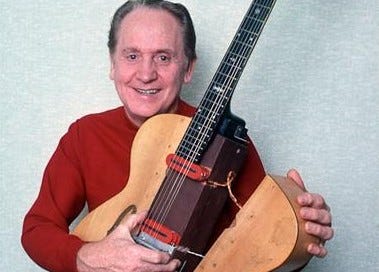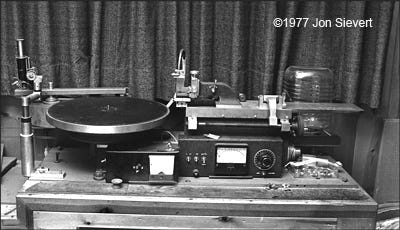Note to readers: This week marks the fifth anniversary of the passing away of Jon Sievert, music photographer extraordinaire. Our friendship and collaborations began when we met at Guitar Player magazine in 1978 and never wavered. I think about him often.
Years ago I asked Jon for permission to use quotes from his brilliant Les Paul cover story for an article I was writing, “Les Paul: A Celebration of Genius.” Jon, living in San Miguel de Allende at the time, happily agreed. In his typical generous way, he also sent along his recollections of his meetings with Les. Here they are.
I first saw Les Paul in 1975 at San Francisco’s Great American Music Hall, a few months after he began performing again following a decade of retirement spurred by his professional and marital split with Mary Ford. By then I’d been working with Guitar Player for several years as a freelance writer and photographer but I wasn’t on assignment this night. I just wanted to see and photograph him for myself.
My parents both loved Les and Mary, so I’d heard his records when I was quite young and was fascinated by their unique sound. By 1975 I also had a pretty good understanding of his importance as a guitar player and inventor. But I was not prepared for the sheer force of his personality as an entertainer.
The band consisted of Les with his son on drums. His son wasn’t very proficient, but it didn’t matter. Les was really a one-man band with his Les Paul, Paulverizer, and overwhelming rapport with the audience. He played many of his old hits and regaled us with stories and corny jokes. It was, and still is, one of the most entertaining performances I’ve ever witnessed.
After the show I went downstairs and introduced myself and told Les about my Guitar Player connection. As a charter member of GP’s Advisory Board, he was effusive and welcoming. I later discovered he was pretty much like that with everyone he met. Then he invited me to visit him at his home in Mahwah, New Jersey, sometime.
I saw him again when he returned to San Francisco the next year. I dragged my portable studio along because I wanted to photograph his iconic guitar that he insisted was the prototype for the Les Paul. Again, he invited me to come to Mahwah.
In those years Guitar Player seldom spent the money to send writers to do interviews outside of the San Francisco Bay Area, so when I decided to visit an old girlfriend in Brooklyn in the summer of 1977, I figured it was time to take him up on his offer. Naturally, editor Don Menn jumped at the idea when I pitched a story.
My friend and I took the morning bus from Brooklyn to Mahwah and got there around 11 a.m., when Les picked us up. It was a large house but there was nothing upstairs that would have tipped anyone off it was the home of a legend. But then we went downstairs and walked into a museum. Gold records (22 of them), guitars, amps, and recording equipment were everywhere. His original studio where all the great hits were made was intact, including the world’s first 8-track sound-on-sound recorder that he invented. It was the perfect place to travel back in time and review a career that already stretched over 50 years.
My first mistake was to bring only three hours of cassettes. Before the day was over, I’d borrowed three more from Les and probably could have used a couple more if we hadn’t had to stop to shoot a cover photo and eat.
All I had to do was ask a simple question and Les was off and running. What an unbelievable and remarkable career he’d had up until then, and it turned out he still had more than 30 years to go. I’ve seen some other fine interviews with Les, but I’ve never read one as comprehensive as the one he gave me that day. I don’t flatter myself it had anything to do with my brilliant interview technique. He was ready to give his story and doing it for Guitar Player allowed him to talk about everything, including the technical stuff that no one else ever asked.
Those were the days when GP was growing every month and Don gave me all the room I wanted to tell the story. When it ran in December 1977, it took almost eight full pages of three-column 8-point type. The funny thing is it could have probably gone for another three or four pages if I hadn’t cut it off because of a tight deadline.
My day with Les ended just before midnight. Because the last bus had left several hours before, he cheerfully drove us back to Brooklyn and told us to come back anytime.
Unfortunately, I never made it back there, but he never forgot my name and even called a couple times just to talk during my five-year stint on staff as a GP editor. My parents were never more impressed with anyone I ever interviewed. When I told Les this, he asked for a copy of one of my photos of him, which he signed with a personal inscription and sent it to them with a nice note. I can still hear his laugh. He was a singular man.
###
Help wanted! To help me continue posting articles like this and producing podcasts of guitar-intensive interviews, please become a paid subscriber ($5 a month, $40 a year) or hit that donate button. Paid subscribers have complete access to all of the 200+ articles and podcasts posted in Talking Guitar. Thank you for your much-appreciated support.
©2025 Jas Obrecht. All right reserved.







Jon was a caring and thoughtful man! Thanks for sharing this great story of his. ❤️